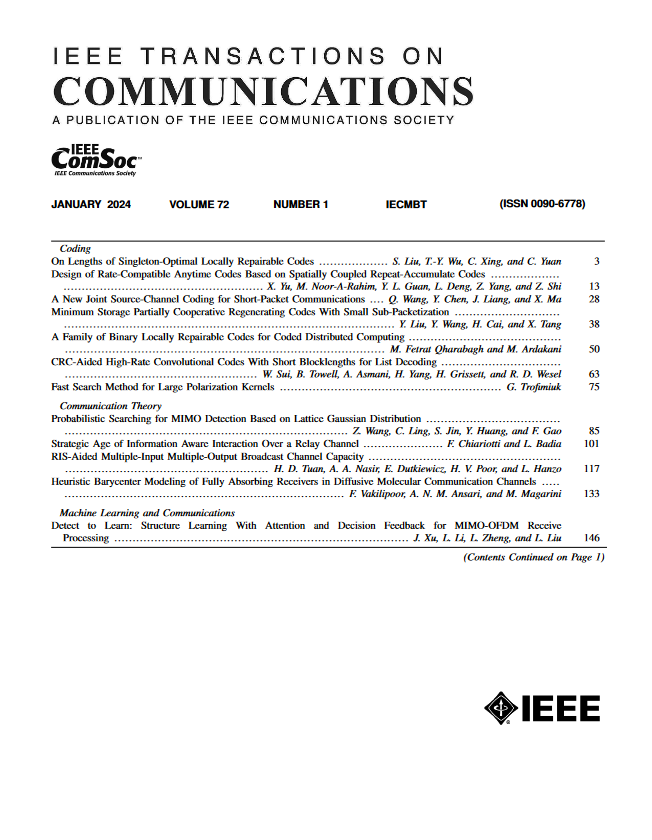宽带智能反射表面辅助无蜂窝网络的高效联合预编码设计
IF 8.3
2区 计算机科学
Q1 ENGINEERING, ELECTRICAL & ELECTRONIC
引用次数: 0
摘要
本文提出了一种有效的联合预编码设计方法,通过联合优化基站的主动波束形成和被动波束形成,使宽带智能反射面辅助无蜂窝网络的加权和速率最大化。由于采用宽带传输,必须考虑红外卫星的频率选择性,其响应通常遵循洛伦兹曲线。为了解决高维非凸优化问题,我们采用分数规划方法将非凸问题解耦为子问题,以便在主动式和被动式波束形成之间交替优化。主动波束形成子问题采用乘法器一致交替方向法(CADMM)解决,被动波束形成子问题采用加速投影梯度法(APG)和Flecher-Reeves共轭梯度法(FRCG)解决。仿真结果表明,与具有理想反射矩阵的原对偶次梯度(PDS)相比,我们提出的方法在各种性能指标下的加权和率都有显著提高。该研究为降低计算复杂度和增强网络容量提供了有价值的见解。本文章由计算机程序翻译,如有差异,请以英文原文为准。
Efficient Joint Precoding Design for Wideband Intelligent Reflecting Surface-Assisted Cell-Free Network
In this paper, we propose an efficient joint precoding design method to maximize the weighted sum-rate in wideband intelligent reflecting surface (IRS)-assisted cell-free networks by jointly optimizing the active beamforming of base stations and the passive beamforming of IRS. Due to employing wideband transmissions, the frequency selectivity of IRSs has to been taken into account, whose response usually follows a Lorentzian-like profile. To address the high-dimensional non-convex optimization problem, we employ a fractional programming approach to decouple the non-convex problem into subproblems for alternating optimization between active and passive beamforming. The active beamforming subproblem is addressed using the consensus alternating direction method of multipliers (CADMM) algorithm, while the passive beamforming subproblem is tackled using the accelerated projection gradient (APG) method and Flecher-Reeves conjugate gradient method (FRCG). Simulation results demonstrate that our proposed approach achieves significant improvements in weighted sum-rate under various performance metrics compared to primal-dual subgradient (PDS) with ideal reflection matrix. This study provides valuable insights for computational complexity reduction and network capacity enhancement.
求助全文
通过发布文献求助,成功后即可免费获取论文全文。
去求助
来源期刊

IEEE Transactions on Communications
工程技术-电信学
CiteScore
16.10
自引率
8.40%
发文量
528
审稿时长
4.1 months
期刊介绍:
The IEEE Transactions on Communications is dedicated to publishing high-quality manuscripts that showcase advancements in the state-of-the-art of telecommunications. Our scope encompasses all aspects of telecommunications, including telephone, telegraphy, facsimile, and television, facilitated by electromagnetic propagation methods such as radio, wire, aerial, underground, coaxial, and submarine cables, as well as waveguides, communication satellites, and lasers. We cover telecommunications in various settings, including marine, aeronautical, space, and fixed station services, addressing topics such as repeaters, radio relaying, signal storage, regeneration, error detection and correction, multiplexing, carrier techniques, communication switching systems, data communications, and communication theory. Join us in advancing the field of telecommunications through groundbreaking research and innovation.
 求助内容:
求助内容: 应助结果提醒方式:
应助结果提醒方式:


